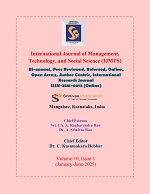Factors Influencing Teachers' Use of Digital Learning Resources in Dakshina Kannada, India: A UTAUT2 Analysis
Main Article Content
Abstract
Purpose: This study used the UTAUT2 (Unified Theory of Acceptance and Use of Technology 2) paradigm to investigate the factors influencing teachers' adoption of Digital Learning Resources (DLR). In addition to examining variations by gender, frequency of technology use, and academic field, this study assesses the influence of Performance Expectancy (PE), Effort Expectancy (EE), Social Influence (SI), Facilitating Conditions (FC), Hedonic Motivation (HM), Price Value (PV), and Habit (HB) on behavioural intention (BI) and use behaviour (UB).
Design/methodology/approach: Data were gathered from 502 teachers in nine taluks in Dakshina Kannada, India using a quantitative study approach and stratified random sampling. Google Forms and offline surveys were used to collect data, and structural equation modelling (SEM) was used for analysis. Group differences were also investigated using one-way analysis of variance (ANOVA) and independent sample t-tests.
Findings: The findings showed that teachers’ BIs were highly influenced by PV, HM, SI, PE, and EE. Use behaviour is greatly influenced by behavioural aims and facilitating circumstances. FC did not affect BI, and HB had no discernible impact on BI or UB. Gender-based BI did not differ significantly according to the group analysis; however, the frequency of technology use and field of study did differ significantly.
Practical implications: This study highlights the need for customised training, improved digital infrastructure, and targeted professional development to enhance the integration of digital tools in education.
Originality/value: This study provides empirical insights into digital adoption patterns among teachers and offers valuable guidance to policymakers and teachers aiming to enhance technology-driven learning environments.
Type of the paper: Original Article
